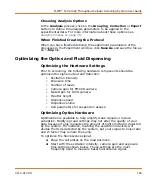
FLIPR
®
Tetra High Throughput Cellular Screening System User Guide
0112-0109 H
163
between wells may be signs that mixing is too slow or not uniform.
Optimal addition parameters typically consist of a fast dispense speed,
low pipettor height, and large addition volume. Assay optimization is
always recommended to determine the proper assay conditions prior to
running a screen.
If addition parameters are not optimized, artifacts will occur affecting
data quality. One common problem is adding compounds too rapidly.
Weakly adherent cells may dislodge from the monolayer, causing a
decrease in fluorescence upon addition. Cell displacement can be
reduced by slowing dispense speed while decreasing addition volume
and increasing height. Larger dispense volumes mix rapidly because
they encounter less surface tension as compared to smaller volumes.
However, small sample volumes are less disruptive to a cell monolayer
and reduce compound consumption. To avoid dislodging weakly
adherent cells, compounds should be added in small volumes and at
relatively low dispense speeds.
For temperature-controlled assays, cell and source plates should be
brought to temperature outside of the instrument. It takes
approximately 45 to 60 minutes in a 95% humid, CO
2
incubator
(15 minutes in a heating block) to warm plates to equilibrium at 37 °C.
Compound Plates for Suspension Assays
Unlike adherent assays, suspension cell assays require cell addition
directly to the compound in the read plates. Compounds are suggested
to be prepared at 2X concentration in the same diluent as used for
cells, since equal volumes of cells will be added to the read plate
containing the compound.
In 384-well assay 25
μ
L cells are added to 25
μ
L 2X compound; in a
1536-well assay 2
μ
L cells are added to 2
μ
L compound.
Plates should be stored covered to prevent evaporation.
Note:
Mixing is not typically used during calcium or membrane
potential assays. Signal artifacts, such as additional noise in the
fluorescent trace, may be attributed to cell disruption induced by rapid
pipettor movement. However, it is not uncommon to use mixing to
resuspend reagents that have fallen out of solution in the source plate.
Содержание FLIPR Tetra
Страница 1: ...FLIPR Tetra High Throughput Cellular Screening System User Guide 0112 0109 H December 2011...
Страница 12: ...Contents 12 0112 0109 H...
Страница 16: ...System Overview 16 0112 0109 H...
Страница 40: ...System Hardware Features 40 0112 0109 H...
Страница 148: ...Exchanging Hardware 148 0112 0109 H...
Страница 156: ...Calibration and Signal Test 156 0112 0109 H...
Страница 196: ...Running an Experiment 196 0112 0109 H...
Страница 232: ...Robotic Integration 232 0112 0109 H The following drawings illustrate these requirements...
Страница 282: ...Data Processing Algorithms 282 0112 0109 H...
Страница 294: ...Consumables and Accessories 294 0112 0109 H...
Страница 298: ...Using AquaMax Sterilant 298 0112 0109 H...
Страница 302: ...Electromagnetic Compatibility EMC 302 0112 0109 H...
















































